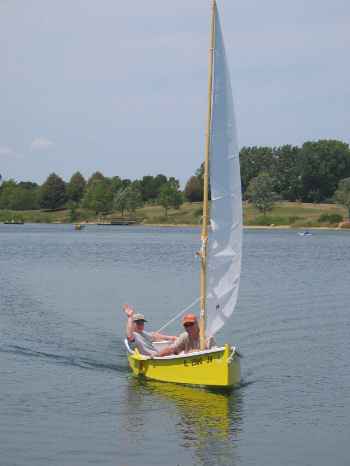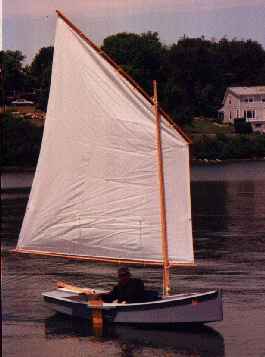
Tom Hamernik & crew sail his new Mixer in Chicagoland.
Contents:
Contact info:
Jim Michalak
118 E Randall,
Lebanon, IL 62254Send $1 for info on 20 boats.
Jim Michalak's Boat Designs
118 E Randall, Lebanon, IL 62254
A page of boat designs and essays.
(1Sep04) This issue will take another look at hull shapes. The 15 September issue will rerun the old outboard fuel consumption report.
THE BOOK IS OUT!
BOATBUILDING FOR BEGINNERS (AND BEYOND)
is out now, written by me and edited by Garth Battista of Breakaway Books. You might find it at your bookstore. If not check it out at the....ON LINE CATALOG OF MY PLANS...
...which can now be found at Duckworks Magazine. You order with a shopping cart set up and pay with credit cards or by Paypal. Then Duckworks sends me an email about the order and then I send the plans right from me to you.
THE 13TH ANNUAL LAKE MONROE MESSABOUT will take place September 17, 18, and 19 at the Paynetown State Recreation Area at Lake Monroe sout of Bloomington, Indiana. For more info contact Bob Bringle at rbringle@iupui.edu.

|
Left:
Tom Hamernik & crew sail his new Mixer in Chicagoland.
|
|
|
Hull Shaping2
HISTORY...I used to write letters back and forth with Phil Bolger twenty years ago, before the internet and before either of us was married. When you get married your patterns of communicating with your buddies changes and eventually I guess we both got too busy to write. But once he sent me an article about hull shaping that he was trying to get published. In his books he would mention his "theory" predicting this and that but never said any details about the theory. I think his article was never published so I am going to try to repeat it as I remember it. So here we present....
THE HULL SHAPING THEORY THAT WOODENBOAT REFUSED TO PRINT!!!
AFLOAT ON SEAS OF PEAS...
This is Phil Bolger theory. I suspect he fell asleep hungry one night and dreamed he was sailing on a sea of frozen peas. As he sped along he saw the individual peas crashing into the hull and getting pushed out of the way. They slid along the hull in a direction perpendicular to the section lines as shown in Figure 2. He could see that the more blunt the hull, the harder the crash of the peas and the greater their resistance.

His first dreamboat was shaped like Figure 2A and it was a nightmare. The bottom was dead flat and the curvature all in the sides. As she pushed through the water the pressure of the peas was higher on the sides as the sides pushed the peas out of the way. The high pressure peas on the hull's curved sides wanted to move toward the flat bottom where the pressure was lower. They swirled around the hard chine in a drag producing vortex. At the stern the opposite happened as the vortex reversed direction to allow the peas to flow from the flat bottom to the lower pressure where the sides pinched inward.

For all the swirling peas she was a slow mean handling boat. The faster she went, the more she wanted to lift her stern and bury her bow.
Phil rolled over and started dreaming again. This time the boat had evolved to lool like Figure 2B. Her sides were flat and all the curvature was in the bottom. The peas still wanted to swirl around the chines but in the opposite direction as the first dreamboat. In this case the bottom had the high pressure in the bow and the low pressure in the stern and she trimmed bow high at speed and she was a better handling job. This shape hull has been used in working scows for a long time and is still universal for working barges. It has maximum deck space and volume of its length. But a short wide one can be a mean thing in rough water.

Phil rolled over again and dreamed the third boat which had its sides and bottom shaped to the same curve as shown in Figure 2C. The front view of this hull shows the line that represents the chine bisecting the angle formed by the bottom and sides. That insures that the sides and bottom have the same curvature, something you can tell with a quick glance at the end view of the lines. Now as the hull pushed through the peas there was equal pressure on the sides and bottom and the peas had no interest in swirling around the chine. Instead they simply flowed straight along the sides and bottom with minimum drag. She still had a trend to trim bow up at speed but that was better than burying her bow.

If the curvature is pronounced, the stem is up well clear of the waves. In light winds she'll sail upright with a minimum of wetted area. In stronger winds she heels to produce a longer waterline. Sail her heeled with one chine flying and she becomes a V bottomed boat cutting smoothly through the chop. This sort of hull has become almost a standard "Bolger sharpie". The simple box shape can deliver smooth water performance under oars, sail or motor comparable if not superior to some much more elaborate hull shapes. It can also be very easy to build have lots of useful volume and stability. It also can get slapped around by rough water.

Bolger claims the ideal sharpie has no flare in it's sides, especially for a pointy bow sharpie. The sides are at right angles to the bottom. I suggest that slight flare angles and small differences in curvature between side and bottom only degrade the theory by small degrees. A little flare or a little curvature variance will increase drag just a little bit. This is unlike using a little twist in the hull's planks which totally negates simple curved panel drafting and requires much more demanding drafting techniques.
Using Seas of Peas theory links together to a great degree the lines of some hulls since the sides and bottom will have the same curvature. If you draw the side view and any cross section, all the remaining cross sections and all of the top view are predetermined. Another approach might be to draw the main cross section and then the chine line in the top view.
All hulls can be examined with Seas of Peas theory in mind, even round bottom hulls. It is just a thought tool to visualize the flow of the water around the hull.

WELL, THAT WAS ABOUT 15 YEARS AGO...
... and I think we have drifted from the theory in attempts to get boats that are more presentable to the eyes of most folks. Boats that Phil did to this theory are like his Martha Jane and Mico (even there I'm not sure they are exactly to the theory) and you see you usually end up with a scow with a very high bow. (The high swept ends also make for quick turning.} I did a few back then to the theory like Pencilbox and Deansbox and Cubit and Jewelbox, Jewelbox Jr, Musicbox2, etc but I suppose like Phil I found folks expect a boat to have a pointy bow.
NEXT TIME...
...We'll take a look at fuel consumption in older outboards.
Mixer

MIXER, ROW/SAIL SKIFF, 12' X 4', 90 POUNDS EMPTY
Mixer is a stab at mixing some features of my prams with the features of the original Roar rowboat. The prototype Mixer was built to perfection by David Boston of Factoryville, Pa. That's him sailing on vacation in Maine.

Mixer's beam is half way betwen that of Piccup, which has "stand up and walk around" stability, and that of Roar, which is too tippy for serious sailing. They all have a similar multichine cross section. Dave was very happy with the stability of the prototype. He reports sailing in white caps with no troubles.
The pointy bow causes a loss in carrying capacity compared to a pram bow. Mixer would need to be stretched at least a foot longer to meet Piccup's capacity. But I left Mixer at 12 feet for two reasons. I've found a 12 footer can be cartopped without bow tiedowns and few new cars have bumpers suitable for bow ties. Longer hulls usually need bow ties (except for narrow jobs like Toto). Also, the 12 footer can still be got out of four sheets of 1/4" plywood and may be a tad lighter than Piccup. At any rate, Dave's Mixer has sailed with two adults aboard and was quite happy.
Mixer's got the exact same interior layout (a 6.5' open cockpit between two large flotation/storage chambers) as Piccup for all the same reasons. So here is a cartopper with capacity for two adults or for camping one adult with a flat floor large enough to sleep on and lots of dry storage. Here is one under construction by Jack Clayton showing some of those features:

The sail rig is identical to Piccup's. If you look at my leeboards you'll see they pivot at a lower hull guard while their tops are braced to take loads both ways and only one board is required. Essentially they are centerboards mounted outside the hull. But no centerboard case is required and there is no need to handle the board in tacking as with loose leeboards. For anyone thinking about converting a centerboard design to leeboards, note that a leeboard should be mounted at the hull's broadest beam to be in flow parallel to the hull's motion. The sail rig then needs to be placed for proper balance. Tom Hamernik's Mixer uses a sail from a Bolger Teal with no mods required to the hull as I recall. Ofter these sharpie sprit sails will sail better than the lug sails provided you can live with the much longer mast.

Plans for Mixer are $20. No lofting or jigs required.
Prototype News
Some of you may know that in addition to the one buck catalog which now contains 20 "done" boats, I offer another catalog of 20 unbuilt prototypes. The buck catalog has on its last page a list and brief description of the boats currently in the Catalog of Prototypes. That catalog also contains some articles that I wrote for Messing About In Boats and Boatbuilder magazines. The Catalog of Prototypes costs $3. The both together amount to 50 pages for $4, an offer you may have seen in Woodenboat ads. Payment must be in US funds. The banks here won't accept anything else. (I've got a little stash of foreign currency that I can admire but not spend.) I'm way too small for credit cards.
The Vireo14 is completed and launched! Boy, that was a fast build:

The AF4G is done and launched. Writeup after testing:

Here is another big project, a 20% scale up of Caprice so it is over 30' long. This will take time.

The out West Picara is rightside up now waiting for its roof:

AN INDEX OF PAST ISSUES
Hullforms Download (archived copy)
Plyboats Demo Download (archived copy)
Brokeboats (archived copy)
Brian builds Roar2 (archived copy)
Herb builds AF3 (archived copy)
Herb builds RB42 (archived copy)